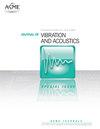Nonlinear Random Vibrations using Second-Order Adjoint and Projected Differentiation Methods
IF 1.9
4区 工程技术
Q2 ACOUSTICS
Journal of Vibration and Acoustics-Transactions of the Asme
Pub Date : 2022-03-08
DOI:10.1115/1.4054033
引用次数: 0
Abstract
This paper proposes a new computationally efficient methodology for random vibrations of nonlinear vibratory systems using a time-dependent second-order adjoint variable (AV2) method, and a second-order projected differentiation (PD2) method. The proposed approach is called AV2-PD2. The vibratory system can be excited by stationary Gaussian or non-Gaussian random processes following the traditional translation process model. A Karhunen-Loeve (KL) expansion expresses each input random process in terms of standard normal random variables. A second-order adjoint approach is used to obtain the required first and second-order output derivatives accurately by solving as many sets of equations of motion (EOMs) as the number of KL random variables. These derivatives are used to compute the marginal CDF of the output process with second-order accuracy. Then, a second-order projected differentiation method calculates the autocorrelation function of each output process with second-order accuracy, at an additional cost of solving as many sets of equations of motion (EOMs) as the number of outputs of interest, independently of the time horizon (simulation time). The total number of solutions of the EOM scales linearly with the number of input KL random variables and the number of output processes. The efficiency and accuracy of the proposed approach is demonstrated using a nonlinear Duffing oscillator problem under a quadratic random excitation and a nonlinear half-car suspension example.非线性随机振动的二阶伴随微分和投影微分方法
本文提出了一种新的计算效率高的非线性振动系统随机振动方法,即二阶随时伴随变量法(AV2)和二阶投影微分法(PD2)。提出的方法被称为AV2-PD2。根据传统的平动过程模型,振动系统可以由平稳高斯或非高斯随机过程来激励。Karhunen-Loeve (KL)展开用标准正态随机变量表示每个输入随机过程。通过求解与KL随机变量数目相等的运动方程集,采用二阶伴随法精确地获得所需的一阶和二阶输出导数。这些导数用于以二阶精度计算输出过程的边际CDF。然后,二阶投影微分方法以二阶精度计算每个输出过程的自相关函数,其额外的成本是求解与感兴趣的输出数量相同的运动方程(eom)集,独立于时间范围(模拟时间)。EOM的解的总数与输入KL随机变量的数量和输出过程的数量呈线性关系。通过二次随机激励下的非线性Duffing振子问题和非线性半车悬架实例验证了该方法的有效性和准确性。
本文章由计算机程序翻译,如有差异,请以英文原文为准。
求助全文
约1分钟内获得全文
求助全文
来源期刊
CiteScore
4.20
自引率
11.80%
发文量
79
审稿时长
7 months
期刊介绍:
The Journal of Vibration and Acoustics is sponsored jointly by the Design Engineering and the Noise Control and Acoustics Divisions of ASME. The Journal is the premier international venue for publication of original research concerning mechanical vibration and sound. Our mission is to serve researchers and practitioners who seek cutting-edge theories and computational and experimental methods that advance these fields. Our published studies reveal how mechanical vibration and sound impact the design and performance of engineered devices and structures and how to control their negative influences.
Vibration of continuous and discrete dynamical systems; Linear and nonlinear vibrations; Random vibrations; Wave propagation; Modal analysis; Mechanical signature analysis; Structural dynamics and control; Vibration energy harvesting; Vibration suppression; Vibration isolation; Passive and active damping; Machinery dynamics; Rotor dynamics; Acoustic emission; Noise control; Machinery noise; Structural acoustics; Fluid-structure interaction; Aeroelasticity; Flow-induced vibration and noise.

 求助内容:
求助内容: 应助结果提醒方式:
应助结果提醒方式:


